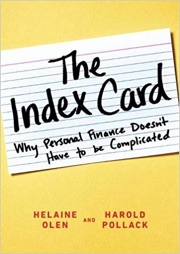 After finishing by Helaine Olen and Harold Pollack, I found it to be a solid all-around personal finance book that joins others like by William Bernstein and by George Clason in the category of “recommended books about money that are short and easily digestible”. All good ideas for gifts for recent graduates.
After finishing by Helaine Olen and Harold Pollack, I found it to be a solid all-around personal finance book that joins others like by William Bernstein and by George Clason in the category of “recommended books about money that are short and easily digestible”. All good ideas for gifts for recent graduates.
They don’t shy away from what I think is the most commonly-ignored financial advice: TRACK YOUR SPENDING FOR THREE MONTHS. Even if you don’t track your budget closely after that, this initial spending diary can be eye-opening. Yes, it takes a bit of effort and can be rather uncomfortable psychologically. Here are some book highlights:
Track ALL of your spending…
For three months, keep track of everything you spend money on, no matter how small. That $1.50 bag of Cape Cod Waffle Cut Sea Salt potato chips? It counts, just as much as your four-figure mortgage or health insurance payment.
… for THREE MONTHS.
If you monitor only one month of spending, you won’t gain a full picture of where your money goes. Routine but sporadic expenses such as car repairs, doctor bills, and the emergency trip to the cat’s vet are more likely to occur over a several-month period.
Now, you can pick your “must keep or I’ll wither away” purchases and the things what won’t hurt as much to cut.
You need to determine what day-to-day spending is necessary and unavoidable, what is a luxury but helps you get through the day, and, finally, what is excess. Only then can you avoid falling prey to spending traps.
This allows you to make trade-offs: I’ll take advantage of the office coffee machine, but I’ll use the money I saved to travel to Italy next summer to attend my best friend’s wedding. I’ll drop my landline phone to pay for my gym membership or boost my child’s college savings.
Final tips. You can put everything on a single credit card or debit card, and then go through your purchases line-by-line. If you use cash, take a picture of your receipts and/or purchases on your phone. If you feel comfortable with it, link your account to Mint.com (or similar) and they will help you categorize things automatically. You’ll need to spend a few weeks teaching it (check in every few days), but it gets better over time.
If you can manage to track everything for three months to get an honest (if uncomfortable and scary!) view of your finances, you may find a big gap between what you think you spend vs. what you really spend. Where does your money go every month?
“The editorial content here is not provided by any of the companies mentioned, and has not been reviewed, approved or otherwise endorsed by any of these entities. Opinions expressed here are the author’s alone. This email may contain links through which we are compensated when you click on or are approved for offers.”
from .
Copyright © 2018 MyMoneyBlog.com. All Rights Reserved. Do not re-syndicate without permission.